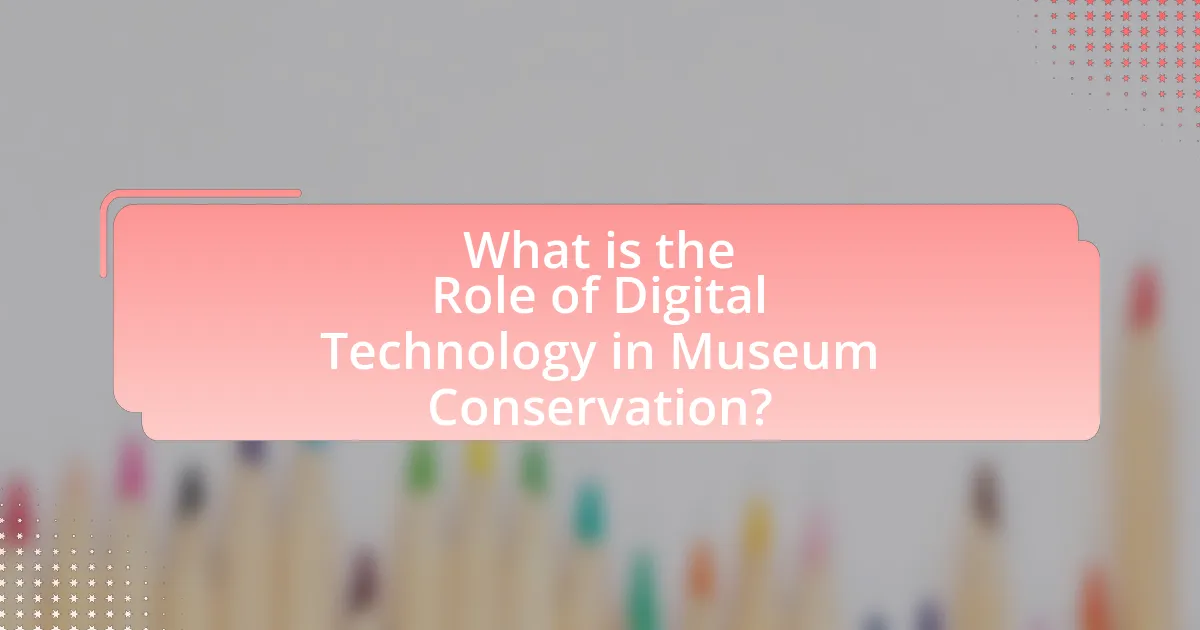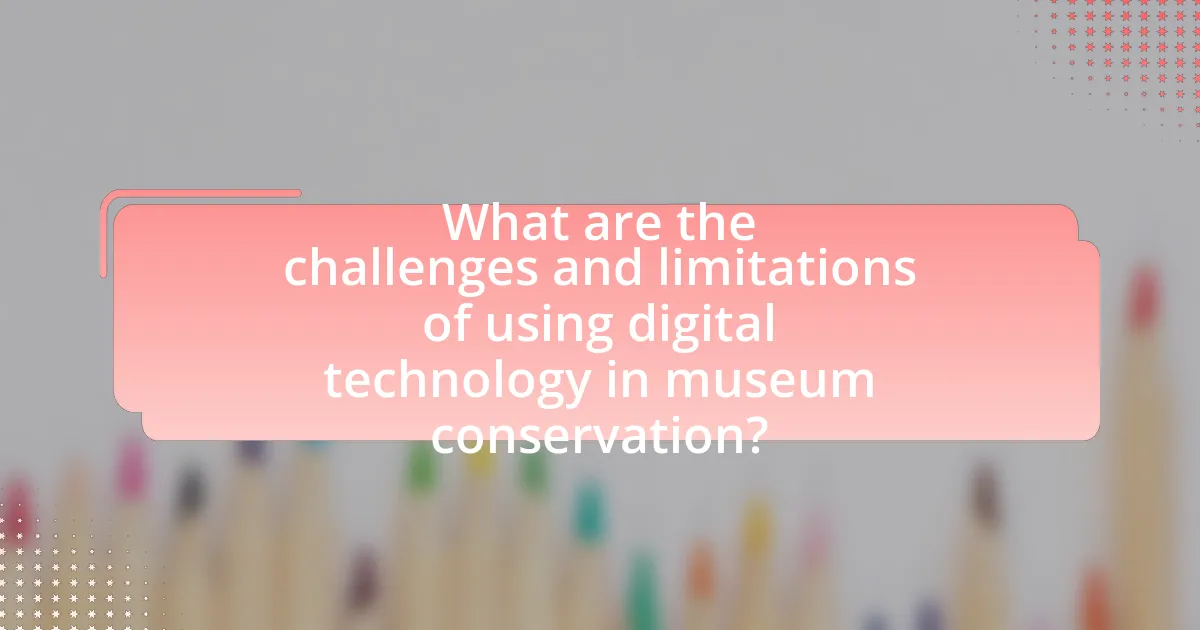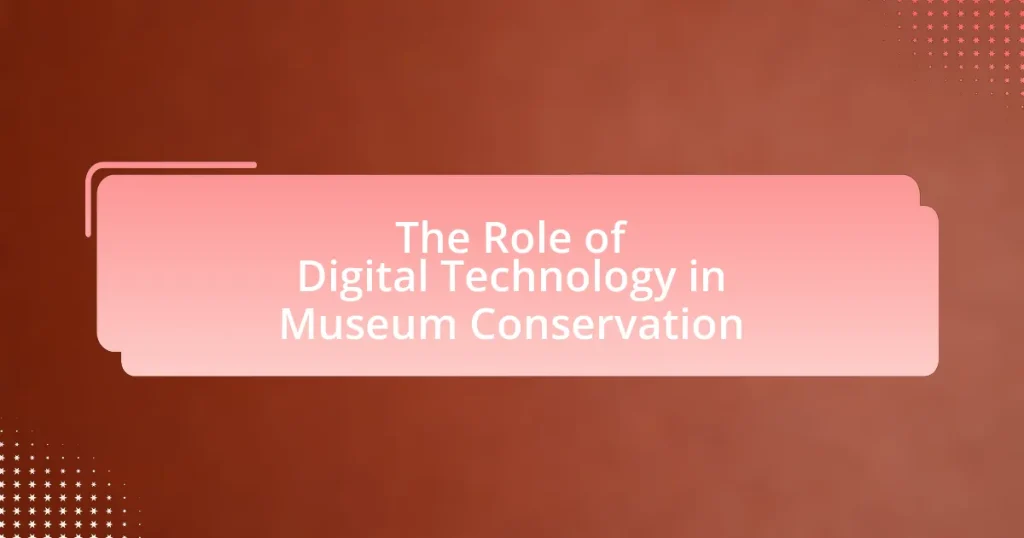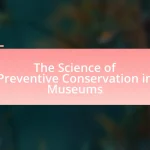Digital technology plays a vital role in museum conservation by improving the preservation, documentation, and accessibility of cultural heritage. Key advancements such as 3D scanning, digital imaging, and climate control systems enhance the monitoring and analysis of artifacts, allowing for timely interventions and reducing deterioration rates. The integration of digital tools facilitates virtual exhibitions and online databases, broadening public access and engagement while addressing challenges faced by traditional conservation methods. This article explores the transformative impact of digital technology on conservation practices, the specific technologies utilized, and the best practices for their implementation in museums.

What is the Role of Digital Technology in Museum Conservation?
Digital technology plays a crucial role in museum conservation by enhancing the preservation, documentation, and accessibility of cultural heritage. It enables the use of advanced imaging techniques, such as 3D scanning and digital photography, which allow for detailed documentation of artifacts and artworks, facilitating better analysis and monitoring of their condition over time. For instance, the use of digital tools can help identify deterioration patterns, enabling conservators to implement timely interventions. Additionally, digital technology supports the creation of virtual exhibitions and online databases, making collections accessible to a broader audience while reducing the physical handling of sensitive items. This integration of technology not only improves conservation practices but also fosters public engagement and education regarding cultural heritage.
How has digital technology transformed museum conservation practices?
Digital technology has significantly transformed museum conservation practices by enhancing documentation, analysis, and preservation methods. For instance, 3D scanning and imaging technologies allow conservators to create detailed digital records of artifacts, enabling precise monitoring of their condition over time. Additionally, digital tools facilitate data analysis through software that can predict deterioration patterns, which helps in developing targeted conservation strategies. The use of digital platforms for sharing information also promotes collaboration among institutions, leading to improved conservation outcomes. These advancements illustrate how digital technology has revolutionized the efficiency and effectiveness of conservation efforts in museums.
What specific technologies are utilized in museum conservation?
Museum conservation utilizes specific technologies such as digital imaging, 3D scanning, and climate control systems. Digital imaging allows for high-resolution documentation of artifacts, enabling detailed analysis and monitoring of their condition over time. 3D scanning creates precise digital replicas of objects, facilitating virtual exhibitions and research without risking damage to the originals. Climate control systems are essential for maintaining optimal environmental conditions, such as temperature and humidity, which are critical for preserving sensitive materials. These technologies collectively enhance the preservation efforts and accessibility of museum collections.
How do these technologies enhance preservation efforts?
Digital technologies enhance preservation efforts by enabling precise documentation, monitoring, and restoration of artifacts. For instance, 3D scanning allows for detailed digital replicas of objects, which can be used for analysis and display without risking damage to the originals. Additionally, environmental monitoring systems track conditions such as temperature and humidity, ensuring optimal preservation environments. Research published in the Journal of Cultural Heritage highlights that these technologies can reduce deterioration rates by up to 30% through proactive management. Thus, the integration of digital tools significantly improves the effectiveness and efficiency of conservation practices in museums.
Why is digital technology important for the future of museum conservation?
Digital technology is important for the future of museum conservation because it enhances preservation methods, improves accessibility, and facilitates research. Advanced imaging techniques, such as 3D scanning and digital archiving, allow for detailed documentation of artifacts, which aids in monitoring their condition over time. For instance, the use of digital tools can help identify deterioration patterns that may not be visible to the naked eye, enabling timely interventions. Additionally, digital platforms expand public access to collections, allowing global audiences to engage with museum artifacts remotely, thereby increasing awareness and appreciation. Furthermore, collaborative digital databases enable researchers to share findings and resources, fostering innovation in conservation practices.
What challenges does traditional conservation face that digital technology addresses?
Traditional conservation faces challenges such as limited accessibility to artifacts, inefficient documentation processes, and the risk of physical deterioration. Digital technology addresses these issues by enabling virtual access to collections, streamlining documentation through digital databases, and facilitating remote monitoring of artifacts’ conditions. For instance, digital imaging techniques allow for high-resolution documentation of artifacts, preserving details that may be lost over time. Additionally, technologies like 3D scanning and augmented reality provide immersive experiences, making collections accessible to a broader audience while reducing the need for physical handling, which can lead to deterioration.
How does digital technology improve accessibility to conservation information?
Digital technology improves accessibility to conservation information by providing online platforms and databases that allow users to access data remotely. These platforms, such as digital archives and interactive websites, enable broader public engagement and facilitate the sharing of conservation practices and research findings. For instance, the Smithsonian Institution’s digital collections provide access to millions of artifacts and conservation records, allowing researchers and the public to explore conservation efforts without geographical limitations. This increased access enhances awareness and education about conservation issues, making vital information available to a global audience.

What are the key applications of digital technology in museum conservation?
Key applications of digital technology in museum conservation include digital imaging, 3D scanning, and data management systems. Digital imaging allows for high-resolution documentation of artifacts, enabling detailed analysis and monitoring of their condition over time. 3D scanning creates accurate digital replicas of objects, facilitating virtual exhibitions and research without risking damage to the originals. Data management systems streamline the cataloging and tracking of conservation efforts, ensuring that information is easily accessible and up-to-date. These technologies enhance preservation strategies and improve accessibility for researchers and the public.
How is 3D scanning used in the conservation of artifacts?
3D scanning is utilized in the conservation of artifacts by creating precise digital replicas that facilitate analysis, documentation, and restoration efforts. This technology captures intricate details of artifacts, allowing conservators to study their condition without physical contact, which minimizes the risk of damage. For instance, the British Museum employs 3D scanning to document its collection, enabling researchers to access high-resolution models for study and comparison. Additionally, these digital models can be used to create physical replicas for educational purposes, ensuring that the original artifacts remain preserved while still allowing public engagement.
What are the benefits of creating digital replicas of artifacts?
Creating digital replicas of artifacts enhances preservation, accessibility, and educational opportunities. Digital replicas protect original artifacts from physical deterioration by allowing for handling and display without risk to the originals. They also enable broader access, as digital versions can be shared globally, allowing people to engage with cultural heritage remotely. Furthermore, these replicas serve as valuable educational tools, facilitating interactive learning experiences in museums and classrooms. For instance, the British Museum’s digital collection allows users to explore artifacts in detail, promoting global engagement and understanding of history.
How does 3D scanning aid in restoration processes?
3D scanning significantly aids in restoration processes by providing precise digital models of artifacts and structures. This technology captures intricate details and dimensions, allowing conservators to analyze the original state of items before damage or deterioration occurred. For instance, the use of 3D scanning in the restoration of the ancient Egyptian tomb of Tutankhamun enabled researchers to create accurate replicas and assess the condition of the original artifacts without physical contact, preserving their integrity. Additionally, 3D models facilitate virtual simulations of restoration techniques, enabling conservators to plan interventions more effectively and minimize risks to the original materials.
What role does digital documentation play in conservation?
Digital documentation plays a crucial role in conservation by providing accurate records of artifacts, their conditions, and treatment histories. This method enhances the ability to monitor changes over time, facilitating informed decision-making regarding preservation strategies. For instance, digital imaging technologies, such as high-resolution photography and 3D scanning, allow conservators to capture detailed visual data, which can be analyzed to assess deterioration or damage. Additionally, databases and digital archives enable efficient organization and retrieval of information, supporting collaborative efforts among conservation professionals. Studies have shown that institutions utilizing digital documentation report improved management of collections and enhanced accessibility for research and public engagement.
How does digital documentation improve record-keeping for artifacts?
Digital documentation significantly enhances record-keeping for artifacts by providing a systematic and efficient method for cataloging, storing, and retrieving information. This technology allows for the creation of detailed digital records that include high-resolution images, provenance data, and conservation history, which can be easily updated and accessed by museum staff and researchers. For instance, a study by the American Alliance of Museums found that institutions utilizing digital documentation reported a 40% increase in the accuracy of their records, demonstrating the effectiveness of this approach in maintaining comprehensive and reliable artifact information.
What software tools are commonly used for digital documentation?
Commonly used software tools for digital documentation include Adobe Acrobat, Microsoft OneNote, and Google Drive. Adobe Acrobat allows users to create, edit, and manage PDF documents, which are essential for preserving and sharing digital records in museum conservation. Microsoft OneNote serves as a digital notebook that facilitates the organization of notes, images, and documents, making it useful for curators and conservators. Google Drive provides cloud storage and collaborative features, enabling teams to access and edit documentation from various locations, which is vital for maintaining up-to-date records in conservation efforts. These tools enhance efficiency and accuracy in the documentation process within the context of museum conservation.

What are the challenges and limitations of using digital technology in museum conservation?
The challenges and limitations of using digital technology in museum conservation include issues related to data integrity, high costs, and the need for specialized training. Data integrity can be compromised due to software malfunctions or data loss, which can affect the accuracy of conservation records. High costs associated with acquiring and maintaining advanced digital tools can strain museum budgets, limiting their ability to implement comprehensive digital strategies. Additionally, the requirement for specialized training means that staff must invest time and resources to effectively utilize these technologies, which can be a barrier for smaller institutions. These factors collectively hinder the seamless integration of digital technology into conservation practices.
What are the potential risks associated with digital conservation methods?
Digital conservation methods pose several potential risks, including data loss, technological obsolescence, and security vulnerabilities. Data loss can occur due to hardware failures, software corruption, or inadequate backup systems, which can jeopardize the integrity of digital archives. Technological obsolescence is a significant concern, as formats and storage media may become outdated, making it difficult to access or retrieve preserved materials over time. Security vulnerabilities arise from the increasing threat of cyberattacks, which can compromise sensitive information and lead to unauthorized alterations or deletions of digital assets. These risks highlight the need for robust strategies in managing and safeguarding digital conservation efforts.
How can data loss impact conservation efforts?
Data loss can severely hinder conservation efforts by eliminating critical information about species, habitats, and historical data necessary for effective management and preservation strategies. When data is lost, researchers and conservationists may lack essential insights into biodiversity trends, population dynamics, and ecological changes, which can lead to misguided conservation actions. For instance, a study published in the journal “Conservation Biology” highlights that data loss can result in the misallocation of resources, ultimately jeopardizing the survival of endangered species. Furthermore, without accurate data, it becomes challenging to assess the effectiveness of conservation programs, making it difficult to adapt strategies based on real-time information.
What are the ethical considerations in using digital technology for conservation?
The ethical considerations in using digital technology for conservation include issues of data privacy, the potential for misrepresentation of artifacts, and the impact on traditional conservation practices. Data privacy concerns arise when digital records of sensitive information about artifacts or cultural heritage are created and shared, potentially exposing them to misuse. Misrepresentation can occur if digital reproductions do not accurately reflect the original object’s condition or context, leading to misunderstandings about its significance. Additionally, the integration of digital technology may overshadow traditional conservation methods, risking the loss of valuable skills and knowledge that have been developed over centuries. These considerations highlight the need for a balanced approach that respects both technological advancements and the integrity of conservation practices.
How can museums overcome the challenges of integrating digital technology?
Museums can overcome the challenges of integrating digital technology by adopting a strategic approach that includes staff training, collaboration with tech experts, and investing in user-friendly platforms. Staff training ensures that museum personnel are equipped with the necessary skills to utilize digital tools effectively, which is crucial as a 2021 survey indicated that 70% of museum professionals felt underprepared for digital transformation. Collaborating with technology experts allows museums to tailor solutions that meet their specific needs, enhancing the visitor experience and operational efficiency. Additionally, investing in user-friendly digital platforms can facilitate easier access to collections and improve engagement, as evidenced by the success of the British Museum’s digital initiatives, which saw a 300% increase in online engagement during the pandemic.
What training is necessary for museum staff to effectively use digital tools?
Museum staff require training in digital literacy, software applications, data management, and digital preservation techniques to effectively use digital tools. This training ensures that staff can navigate various digital platforms, utilize museum management systems, and implement best practices for preserving digital assets. Research indicates that comprehensive training programs enhance staff competency in using technology, which is crucial for modern museum operations and conservation efforts. For instance, a study by the American Alliance of Museums highlights that institutions with robust digital training initiatives report higher staff confidence and efficiency in managing digital resources.
How can collaboration with tech companies enhance conservation efforts?
Collaboration with tech companies can enhance conservation efforts by leveraging advanced technologies such as artificial intelligence, data analytics, and remote sensing to monitor and protect ecosystems. For instance, AI algorithms can analyze large datasets to identify patterns in wildlife populations, enabling targeted conservation strategies. Additionally, remote sensing technologies, like satellite imagery, provide real-time data on habitat changes, allowing conservationists to respond swiftly to environmental threats. A study by the World Wildlife Fund in 2021 demonstrated that integrating technology in conservation efforts led to a 30% increase in the effectiveness of wildlife monitoring programs. This evidence underscores the significant impact that tech partnerships can have on improving conservation outcomes.
What best practices should museums follow when implementing digital technology in conservation?
Museums should prioritize the integration of digital technology in conservation by adopting best practices that ensure the preservation and accessibility of cultural heritage. First, they should conduct thorough assessments of existing collections to identify which items would benefit most from digital documentation and monitoring. This approach is supported by the International Council of Museums, which emphasizes the importance of systematic inventory and condition reporting as foundational steps in conservation efforts.
Next, museums should utilize high-resolution imaging and 3D scanning technologies to create detailed digital records of artifacts. This practice not only aids in monitoring the condition of items but also facilitates virtual access for researchers and the public, enhancing educational outreach. Research published in the Journal of Cultural Heritage Management and Sustainable Development highlights that digital documentation can significantly improve the understanding and management of collections.
Furthermore, museums must ensure that digital technologies are accompanied by robust data management systems that allow for secure storage and easy retrieval of information. Implementing standardized metadata practices, as recommended by the Digital Preservation Coalition, enhances interoperability and long-term accessibility of digital assets.
Lastly, ongoing training for staff in both conservation techniques and digital tools is essential. Continuous professional development ensures that museum personnel are equipped to effectively utilize emerging technologies, thereby maximizing their impact on conservation efforts. The American Institute for Conservation advocates for such training as a means to keep pace with technological advancements in the field.
How can museums ensure the longevity of digital records?
Museums can ensure the longevity of digital records by implementing robust digital preservation strategies. These strategies include regular data backups, utilizing multiple storage formats, and employing metadata standards to maintain accessibility and context. For instance, the Library of Congress emphasizes the importance of using diverse storage solutions, such as cloud services and physical media, to mitigate risks associated with data loss. Additionally, adhering to established digital preservation frameworks, like the Digital Preservation Coalition’s guidelines, helps museums systematically manage and protect their digital assets over time.
What strategies can be employed to balance traditional and digital conservation methods?
To balance traditional and digital conservation methods, museums can implement an integrated approach that combines the strengths of both methodologies. This strategy involves using digital tools for documentation and analysis while maintaining traditional hands-on techniques for preservation. For instance, digital imaging technologies, such as 3D scanning, can create accurate records of artifacts, which aids in monitoring their condition over time without physical handling. Research by the Getty Conservation Institute highlights that combining digital documentation with traditional conservation practices enhances the overall effectiveness of preservation efforts. This dual approach ensures that the tactile, experiential aspects of traditional methods are preserved while leveraging the efficiency and precision of digital technologies.


